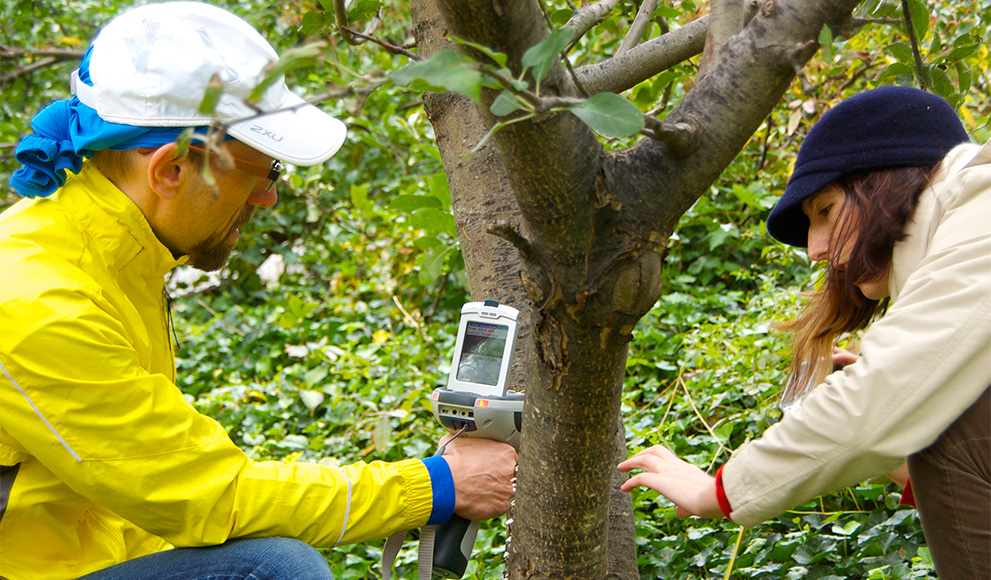Wellesley Researchers Aid Community Group And Find Surprising Data on Fruit Harvested in Urban Areas

It's not widely known, but apple, peach and cherry trees (and other fruits and herbs) grow in unexpected places throughout the Boston metro area—along highways, in urban parklands, or outside of residential properties, for example. Dan Brabander, professor of geosciences, and his students have been studying the fruit from these trees as part of a one-of-a-kind research partnership with the League of Urban Canners (LUrC), an area "community food production" group. This citizen-scientist collaboration is garnering bushels of attention, including a recent Boston Globe story.
Members of the LUrC seek out, nurture, and harvest edibles from about 100 trees scattered in local urban areas, consuming what they find fresh or in preserves, ciders, and jams. However, when one member of the group's blood tested high for lead levels, League members became concerned. Could their sites be tainted? They turned to Brabander, who had previously studied lead exposure risk in urban gardens and in areas impacted by historical mining activities, for an answer.
Brabander saw an opportunity not only to answer their question but also to give his students both valuable research experience and the chance to take part in a community partnership study. "It's an example of a successful approach to doing applied science that matters," Brabander told the Globe. In an email, he explained just what makes the experience so valuable. His students, he said, are "experiencing the full enterprise of doing applied science—building meaningful partnerships with not-for-profit organizations; planning field work and executing lab work; and reporting back to both the people impacted by our research and the greater scientific community."
The team began taking samples and conducting fieldwork from "urban agriculture" sites in Cambridge, Somerville and Boston, examining lead levels as well as concentrations of micronutrients. "Each of us worked on every aspect of the project, which enhanced the overall experience, allowing for us to learn and develop a range of skills through the project rather than focusing in on one specific part of the process," said Disha Okhai ‘17, a geosciences major.
Assisted by collections from LUrC, the students visited a variety of urban sites to gather specimens, which they then brought back to Brabander’s lab on campus. After collecting nearly 200 samples of apples, peaches, cherries and other urban fruits and herbs, analyzing forty to date, the team found that eating urban fruit is not a significant source of lead exposure, when compared to the EPA-regulated benchmark for lead in drinking water. They also found that, compared to commercially grown fruits, urban apples and peaches had higher concentrations of calcium, iron and other micronutrients.
"We’re excited about these initial results, and the biggest surprise is the micronutrients," Brabander told the Globe. "I think there’s a growing realization that urban environments can support a wide range of agricultural activities, from food projects to community gardens to foraging."
Their study, which has direct applications for public health and for urban harvesters, has been covered in dozens of media outlets, including the Globe and The Atlantic Monthly, science publications and a podcast for Scientific American. Students on the project team also presented their findings at the annual meeting of the National Geographic Society earlier this month in Baltimore.
According to Ciaran Gallagher '17, more research needs to be done but, she explained, their results could be good news for urban harvesters. "We hope that our efforts will eventually aid the urban harvesting/foraging movement, which promotes the diversion of a waste stream (uneaten urban fruit) and fosters community," she said.
Hannah Oettgen '17, a geosciences major, added, "Hopefully, eventually our results can be applied to other cities. As harvesting is on the rise in many urban settings, I think that our partnership with LUrC and the results that we have been getting can show the many benefits of the seasonal fresh fruit that exists on fruit trees [in urban settings]."
"And for those wondering," Brabander offered, "Yes, we often eat the fruit and are grateful for the offers of produce while out in the field. Field work always seems to make us hungry."
